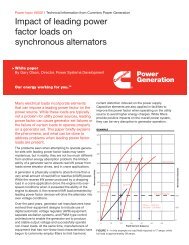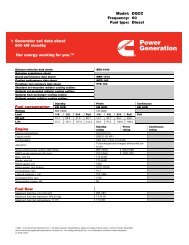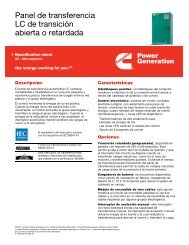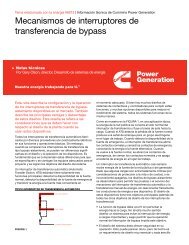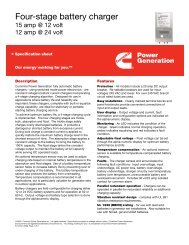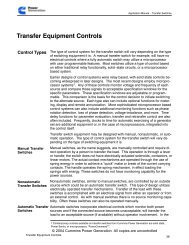appendix
appendix
appendix
You also want an ePaper? Increase the reach of your titles
YUMPU automatically turns print PDFs into web optimized ePapers that Google loves.
Application Manual – Liquid Cooled Generator Sets<br />
Whenever a reduced voltage starter is used for a fire pump motor, the user should<br />
consider sizing for across–the–line starting because the fire pump controller includes<br />
either a manual–mechanical, manual–electrical, or automatic means to start the pump<br />
across–the–line in the case of a controller malfunction. GenSize will not disallow use of<br />
reduced voltage starters for fire pumps, however.<br />
RkW If HP entered: RkW = HP x 0.746 ÷ Running Efficiency<br />
If kW entered: RkW = kW ÷ Running Efficiency<br />
If Ramps entered: 1∅ RkW = (Ramps x voltage x RPF x Efficiency) ÷ 1000<br />
3∅ RkW = (Ramps x voltage x RPF x Efficiency x 1.73)<br />
÷ 1000<br />
RkVA RkVA = RkW ÷ RPF<br />
RPF Running power factor as entered or default from database<br />
SkW High Inertia SkW = SkVA x SPF<br />
Low Inertia SkW = SkVA x SPF x 0.6<br />
SkVA SkVA = HP x (LRkVA/HP) x SkVA factor, where LrkVA/HP is the average kVA/HP<br />
for the NEMA Code letter of the motor, and SkVA factor is 1.0 for full voltage<br />
starting, or from reduced voltage starting table (see Reduced Voltage Starting<br />
Method)<br />
SPF As entered, or default values from database by HP and starting method<br />
PkW PkW = SkW<br />
PkVA PkVA = SkVA<br />
AkW (non–VFD) AkW = RkW except solid–state starter where AkW = 2.0 x RkW<br />
unless a bypass contactor is used, then AkW = RkW<br />
AkW (VFD) Conventional AC Inverter: AkW = 2.0 x RkW<br />
Pulse Width Modulated: AkW = 1.4 x RkW<br />
DC Drive: AkW = 2.0 x RkW<br />
Ramps 1∅ Ramps = (HP x 746) ÷ (voltage x Efficiency x RPF)<br />
3∅ Ramps = (HP x 746) ÷ (1.73 x voltage x Efficiency x RPF)<br />
UPS Load Calculations<br />
A static UPS uses silicon controlled rectifiers (SCR) or another static device to convert<br />
AC voltage to DC for charging batteries, and an inverter to convert DC to conditioned AC<br />
power to supply the load. A UPS is a non–linear load and may require an oversized<br />
alternator. Some incompatibility problems between generator sets and static UPSs have<br />
led to many misconceptions about sizing the generator set for this type of load. Past<br />
problems did occur, and the recommendation from UPS suppliers at that time was to<br />
oversize the generator set from two to five times the UPS rating. Even then some<br />
problems persisted, and since then those incompatibility problems have been addressed<br />
by most UPS manufacturers. It is more cost effective to require generator compatibility of<br />
the UPS supplier than to oversize the generator.<br />
If the batteries are discharged when the UPS is operating on the generator set, the<br />
generator set must be capable of supplying the rectifier for battery charging and the<br />
inverter to supply the load. A second reason to use the full UPS rating is that additional<br />
UPS load may be added in the future up to the nameplate rating. The non–linear load<br />
sizing factors used by GenSize are based on the level of harmonics the UPS induces in<br />
the generator output with the UPS fully loaded. Since the harmonics increase at lighter<br />
loads, selecting the larger capacity alternator helps to offset this effect.<br />
For multiple redundant UPS systems, size the generator set for the combined nameplate<br />
ratings of the individual UPSs. Redundant system applications are those where one UPS<br />
is installed to back up another and the two are on–line at all times with 50% or less load.<br />
UPS equipment often has varying power quality requirements depending on the operating<br />
mode. When the rectifier is ramping up, often relatively broad frequency and voltage<br />
swings can occur without disrupting equipment operation. However, when the bypass is<br />
enabled, both frequency and voltage must be very constant, or an alarm condition will<br />
A–12 APPENDIX A<br />
Rev. Jan 2011





